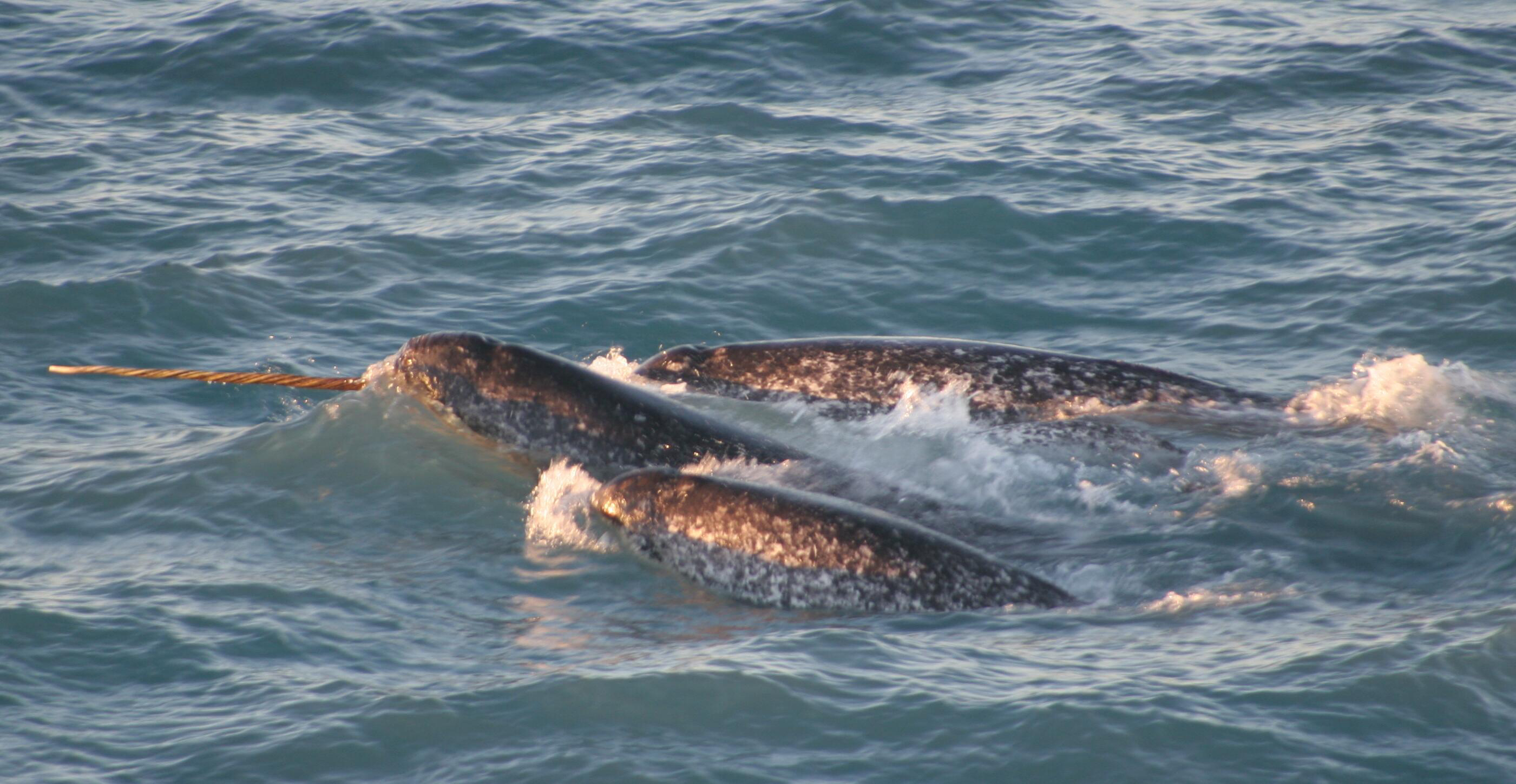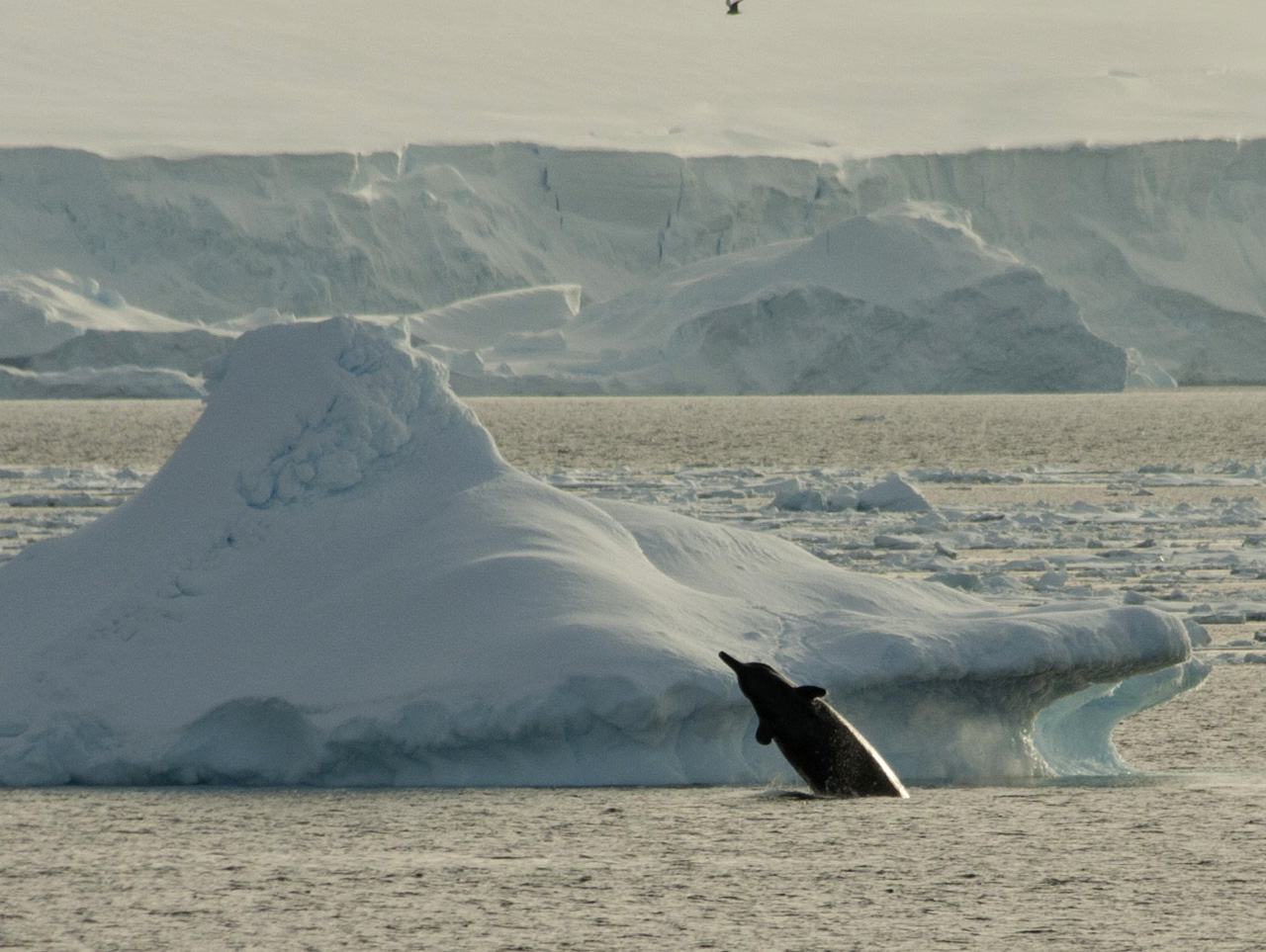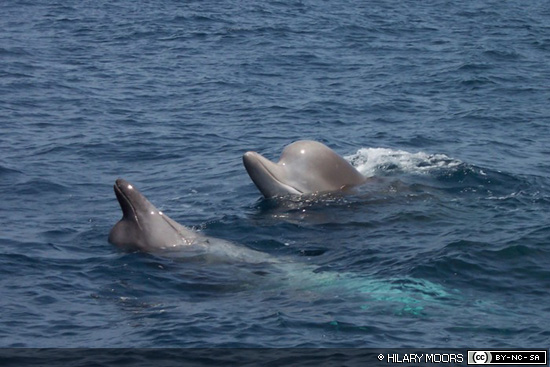Translations:AY Honors/Marine Mammals/Answer Key/44/en
Beluga Whale (Delphinapterus leucas)
Where found: Arctic and sub-arctic oceans around North America, Russia and Greenland.
Description: Adapted to life in the Arctic, it has a number of anatomical and physiological characteristics that differentiate it from other cetaceans. The unmistakable all-white colour, absence of a dorsal fin, and the distinctive protuberance at the front of its head which houses an echolocation organ called the melon. The beluga’s body size is between that of a dolphin’s and a true whale’s, with males growing up to 5.5 m (18 ft) long and weighing up to 1,600 kg (3,500 lb). This whale has a stocky body; it has the greatest percentage of blubber. Its sense of hearing is highly developed and it possesses echolocation, which allows it to move about and find blowholes under sheet ice. Belugas form groups of up to 10 animals on average, although during the summer months, they can gather in the hundreds or even thousands in estuaries and shallow coastal areas. They are slow swimmers, but they can dive down to 700 m (2,300 ft) below the surface. They are opportunistic feeders and their diets vary according to their locations and the season. They mainly eat fish, crustaceans and other deep-sea invertebrates. Worldwide population is thought be around 150,000 individuals. They are migratory and the majority of groups spend the winter around the arctic ice cap; but when the sea ice melts in summer, they move to warmer river estuaries and coastal areas. Belugas are one of the cetaceans most commonly kept in captivity in aquaria and wildlife parks in North America, Europe and Asia where they are popular with the public due to their colour and expressivity. Wilma the Beluga Whale
Narwhal (Monodon monoceros)
Where found: Arctic and sub-arctic oceans around North America, Russia and Greenland.
Description: Adapted to life in the Arctic, Narwhale Nat Geo. These small whales have a long tusk (actually an elongated left canine tooth) protruding from the mouth. They eat fish which they hunt beneath the pack ice of arctic waters. Thy do not have a dorsal fin as most whales and dolphins do. Narwhals range from 4 to 5.5 meters (13-18 feet) in length.
Sperm Whale (Physeter macrocephalus)
Where found: The sperm whale can be found anywhere in the open ocean.
Description: Largest of the toothed whales and largest toothed predator in the world. The Sperm Whale breaks all kinds of records! Mature males may reach 20.5 metres (67 ft) and 57,000 kilograms (males much larger than females). It is the loudest of any animal, second deepest diving mammal with dives of up to 90 minutes, largest brain (five times heavier than a human brain), 116 kg (255 lbs) heart, longest intestinal system (exceeding 300 m in larger specimens) and other mind blowing measurements. The sperm whale's distinctive shape comes from its very large, block-shaped head, which can be one-quarter to one-third of the animal's length. The S-shaped blowhole is located very close to the front of the head and shifted to the whale's left, giving a distinctive bushy, forward-angled spray. Primary food is squid and they can live for more than 60 years. The sperm whale's flukes are triangular and very thick. Proportionally, they are larger than that of any other cetacean, and are very flexible. The whale lifts its flukes high out of the water as it begins a feeding dive. It has a series of ridges on the back's caudal third instead of a dorsal fin. The largest ridge was called the 'hump', and can be mistaken for a dorsal fin because of its shape and size. In contrast to the smooth skin of most large whales, its back skin is usually wrinkly and has been likened to a prune by whale-watching enthusiasts. From the early 18th century through the late 20th the species was a prime target of whalers. The head of the whale contains a liquid wax called spermaceti, which was used in lubricants, oil lamps, and candles. Ambergris, a waste product from its digestive system, is still used as a fixative in perfumes. The Sperm Whale is now protected by a whaling moratorium, and is currently listed as vulnerable. Sperm whales have sunk ships, including the real life Moby Dick who sunk the Essex. Jonathan Bird's Blue World: Sperm Whales
Pygmy & Dwarf Sperm Whales (Kogia breviceps)
Where found: Dwarf and Pygmy sperm whales are found throughout the tropical and temperate waters of the Atlantic, Pacific and Indian Oceans. However, they are rarely sighted at sea, so most data come from stranded and captured animals - making a precise range and migration map difficult. The dwarf is more coastal than the pygmy. There is no accurate estimate of number of these whales in the world or good data on conservation status.
Description: The dwarf sperm whale is the smallest species commonly known as a whale. It grows up to 2.7 m (8.9 ft) in length and 250 kilograms (550 lb) in weight. The species makes slow, deliberate movements with little splash or blow and usually lies motionless when at the sea's surface. Consequently it is usually observed only in very calm seas. These two species were not distinguished from each other until 1966 and are difficult to tell apart but the dwarf is slightly smaller and has a larger dorsal fin than the pygmy. The body is mainly bluish gray with a lighter underside with slightly yellow vein-like streaks possibly visible. There is a white false gill behind each eye. The flippers are very short and broad. The top of the snout overhangs the lower jaw, which is small. The whales have long, curved and sharp teeth (0–6 in the upper jaw, between 14 and 26 in the lower). These whales expel a dark reddish substance when frightened or attacked—possibly to put off any predators. They are usually solitary or paired but have occasionally been seen in small groups. All sperm whales have a spermaceti organ in the forehead. The brain of the dwarf sperm whale is roughly half a kilogram in mass.Video of stranded Pygmy Sperm Whale
Giant Beaked Whale/Arnoux and Baird’s Beaked Whales (Berardius)
Where found: Arnoux’s beaked whale Berardius arnuxii lives in cold Southern Hemisphere waters and Baird’s beaked whale Berardius bairdii is found the cold temperate waters of the North Pacific.
Description: You would not be able to see the differences between Arnoux and Baird’s beaked whales except that they live on opposite ends of the world. They grow to 10–12 m in length and up to 14,000 kg (31,000 lb). They have very long prominent beak, even by beaked whale standards. The lower jaw is longer than the upper and the front teeth are visible even when the mouth is fully closed. The melon is particularly bulbous. The body shape is slender - the girth is only 50% of length. The body is uniformly coloured and a particular individual's colour may be anything from light grey through to black. The flippers are small, rounded and set towards the front of the body. The dorsal fin similarly is small and rounded and set about three-quarters of the way along the back. Adult males and females of both species pick up numerous white linear scars all over the body as they age and may be a rough indicator of age.
- B. arnuxii is known as Arnoux's beaked whale, southern four-toothed whale, southern beaked whale, New Zealand beaked whale, southern giant bottlenose whale, and southern porpoise whale.
- B. bairdii is known as Baird's beaked whale, northern giant bottlenose whale, North Pacific bottlenose whale, giant four-toothed whale, northern four-toothed whale, and North Pacific four-toothed whale.
Northern and Southern Bottlenose Whales (Hyperoodon)
Where found: Northern bottlenose whale are found in the North Atlantic Ocean and is found in cool and subarctic deep waters such as the Davis Strait, the Labrador Sea, the Greenland Sea and the Barents Sea and as far south as Cape Verde Islands. Southern bottlenose whales are probably the most abundant whale in Antarctic waters.
Description: These sister species are fairly rotund with an extremely bluff melon. The beak is long and white on males but grey on females. The dorsal fin is relatively small at 30–38 centimetres (12–15 in) and set behind the middle of the back. It is falcate (sickle-shaped) and usually pointed. The Northern species measures 9.8 metres (32 ft) in length when physically mature. The back is mid-to-dark grey, with a lighter underside. The Southern bottlenose whale smaller growing to 7.5 m (25 ft) in length when physically mature. The back is light-to-mid grey, also with a lighter underside. Males are about 25% larger than females. These bottlenose whales live up to 37 years. Weight estimates are hard to come by. For the northern bottlenose whale, 5,800–7,500 kilograms (12,800–16,500 lb) is given somewhat consistently, while the smaller and less studied southern species will be lighter. The bottlenose whales are some of the deepest diving mammals known, reaching depths of 1453 m (4767 ft) The whales feed on squid, sea cucumbers, herring, cuttlefish, sea stars and other benthic invertebrates.Video Northern Bottlenose Whale
Cuvier's beaked whale (Ziphius cavirostris)
Where found: Open ocean worldwide except in the Arctic and Southern oceans.
Description: The Cuvier's beaked whale or goose-beaked whale is the most widely distributed of all the beaked whales. Individuals commonly have white scars and patches caused by cookiecutter sharks. It prefers depth greater than 1,000 m (3,300 ft) and avoids ships, it is still one of the most frequently spotted beaked whales. The maximum known depth reached by the Cuvier's beaked whale is 2,992 metres (9,816 ft), or 1.8 miles, making it the deepest-diving mammal. The species name comes from Greek xiphos, "sword", and Latin cavus, "hollow" and rostrum, "beak", referring to the indentation on the head in front of the blowhole. The body of Cuvier's beaked whale is robust and cigar-shaped, similar to those of other beaked whales and can be difficult to distinguish from many of the mesoplodont whales at sea. Males and females are the same size up to about 5–7 m (16–23 ft) in length 2,500 kg (5,500 lb). The dorsal fin is curved, small and located two-thirds of the body length behind the head. Flippers are equally small and narrow and can be tucked into pockets in the body wall, presumably to prevent drag while swimming. Like other beaked whales, its flukes are large and lack the medial notch found in all other cetaceans. The head is short with a small, poorly defined rostrum and a gently sloping melon. A pair of throat grooves allow the whale to expand this region when sucking in its prey. Cuvier's beaked whale has a short beak in comparison with other species in its family, with a slightly bulbous melon. The melon is white or creamy in color and a white strip runs back to the dorsal fin about two-thirds of the way along the back. The rest of the body color varies by individual: some are dark grey; others a reddish-brown. The dorsal fin varies in shape from triangular to highly falcate, whilst the fluke is about one-quarter the body length. They live for forty years. Culvers beaked whale
Dolphins and porpoises are also classified as toothed whales, but since they appear as a separate group in this requirement, they are not listed here.







